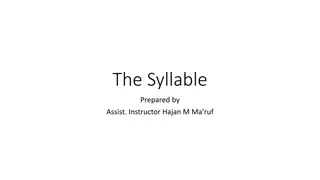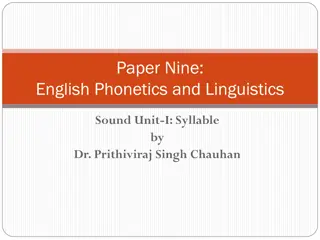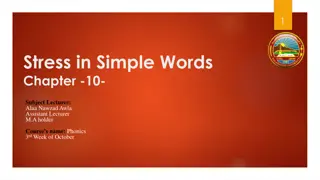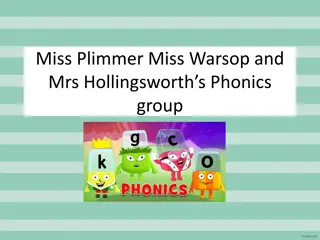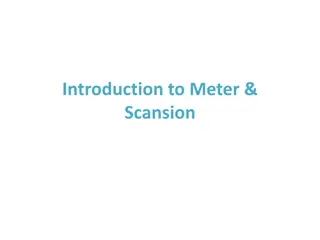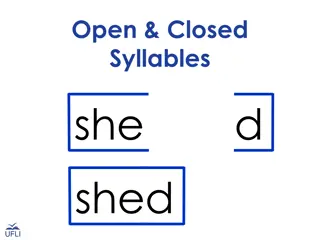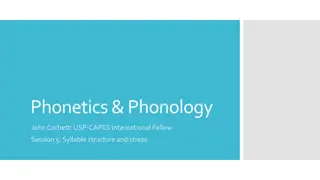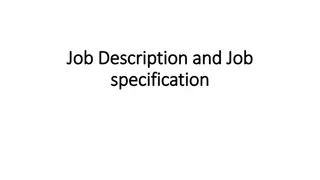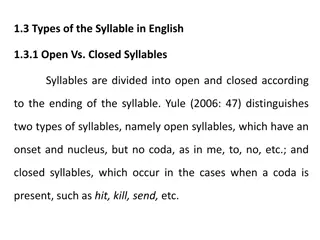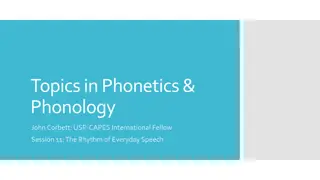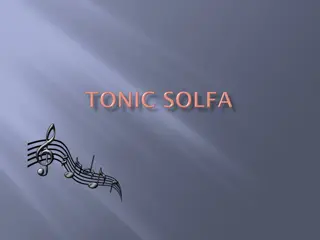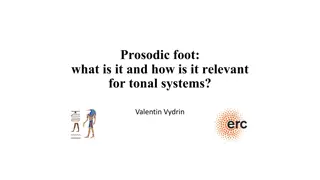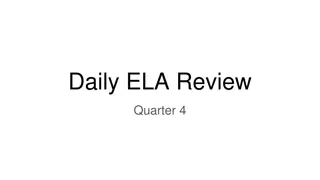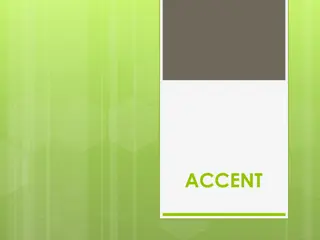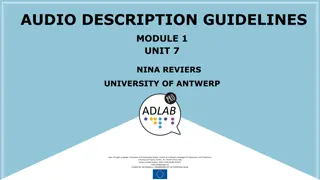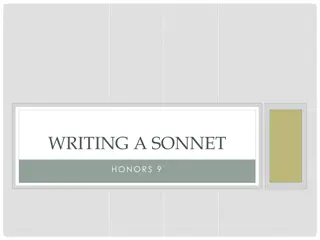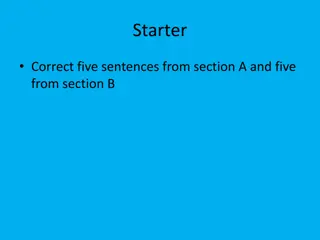Understanding English Syllables: Structure and Description
Explore the concept of syllables in English phonetics through an in-depth analysis of syllabic structure, sonority, constituents, rhyme, nucleus, coda, and phonological perspectives. Delve into the definition of a syllable, its importance in speech production, and the phonetic descriptions of syllabic elements. Gain insight into the sonority scale and the role of syllables in phonological organization according to linguistic theories.
Download Presentation

Please find below an Image/Link to download the presentation.
The content on the website is provided AS IS for your information and personal use only. It may not be sold, licensed, or shared on other websites without obtaining consent from the author. Download presentation by click this link. If you encounter any issues during the download, it is possible that the publisher has removed the file from their server.
E N D
Presentation Transcript
PEOPLE S DEMOCRATIC REPUBLIC OF ALGERIA Ministry of Higher Education and Scientific Research University of Ben Boulaid Moustafa, Batna-2 Algeria Faculty of Letters and Foreign Languages Department of English Second Year Phonetic Courses TEACHER. Dr.RAHMANI. A Academic year 2020-2021
Course Two: Syllables in English Structure and Description of English Syllables Syllabic Consonants
What is a syllable What is a syllable(phonetically) What is sonority What is a syllables(phonologically) What are its constituents Oncet
Rhyme Nucleus Coda Tree diagram Closed syllables Open syllables Phonetitics
Defining a Syllable A unit of speech for which there is no satisfactory definition. Syllables seem to be necessary units in the mental organization and production of utterances. (Ladefoged & Johnson pg. 318).
Phonetic Definitions of the Syllable We can start with a purely phonetic description of the syllable: One possible theory is that peaks of syllabicity coincide with peaks of sonority
*Sonority scale adopted by (McMahon, 2002:107) will be graded in this diagram as follows: Low vowels [ , ] More sonorous High vowels [I, u] Glides [j, w] Liquids [l, r] Nasals [m, n, ] Voiced fricatives [v, , z, ] Voiceless fricatives [f, , s, , h] Voiced plosives (stops) [b, d, g, d ] Voiceless plosives (stops) [p, t, k, t ] Less sonorous Diagram : The sonority scale of the English sounds
Syllables in Phonology Let s consider now syllables from a phonological point of view where they are most abstract units of organization. Chomsky & Halle s Sound Pattern of English (1968) didn t define the syllable. Words were considered to be strings of segments, and one may manage to describe phonological patterns without them.
BUT Without referring to syllables, how might we describe why we can t say knee as [kni] but acne as [ kni] is fine? OR What about the patterning of clear [l] vs. dark [ ] l? Consider how /l/ patterns in the following words: bowl [b ( )] ebola [ib l ] love [l v] polka [p ( )k ]
Syllables in Languages *Every language manifests a particular way of combining its sounds to form meaningful words or parts of words, called syllables. *Each language puts certain restrictions on these possible combinations. For example, in English we can't have a word which begins with a consonant sequence bfj, zbf or tzp. *When we analyse what restrictions (and regularities) are found in the language under study,in our case English lge, we are studying the syllable structure of that language.
*We can divide words into one or more syllables. For example, tin has one syllable, brother has two, important has three and computer has four syllables each. *A syllable is a group of one or more sounds. The essential part of a syllable is a vowel sound (V) which may be preceded and/or followed by a consonant (C) or a cluster of consonants (CC or CCC). Some syllables consist of just one vowel sound (V) as in I and eye/aI/, owe/ /.
In English, a syllable can consist of a vowel preceded by one consonant (CV) as in pie/paI/, or by two consonants (CCV) as in try/traI/, or by three consonants (CCCV) as in spry/spraI/. The vowel of the syllable may also be followed by one consonant (VC) as in at/ t/, or by two consonants (VCC) as in its/Its/, or by three consonants (CVCCC) as in text/tekst/or by four consonants (CVCCCC) as in texts/teksts/.
c CONSONANT v cc ccc C CC CONSONANT v CCC CCCC
What you should highly consider Crosslinguistically, different languages have different requirements for what types of syllables are allowed. Words can be cut up into units called syllables. Humans seem to need syllables as a way of segmenting the stream of speech and giving it a rhythm of strong and weak beats. Syllables exist only to make speech easier for the brain to process. A word contains at least one syllable CV is considered the most basic syllable type and is allowed in every language.
Syllable Structure The syllable (conventionally marked as small Greek sigma: ) has two constituents (it branches into two elements, to put it in another way) the Onset (O), which includes any consonants that precede the nuclear element (the vowel), and the Rhyme (R), which includes the nuclear element (the vowel) as well as any other elements (consonants) that might follow it.
Syllable struture / / / / \ O N CO \ R
The Rhyme, further branches into Peak (P), also known as Nucleus (N), and Coda (Co). The Peak (Nucleus), as the designation suggests, represents the nuclear or most sonorous element in a syllable. The Coda includes all consonants that follow the Peak in a syllable.
Tree Diagram of CAT: / / R / / \ O N CO l / \ C V C l / \ K t \
Syllable =Onset(O) +Rhyme Rhyme = nucleus + coda
Closed Syllable, Open Syllable Syllables ending in a consonant, e.g. cat /k t/, it / t/, eat /i:t/, are traditionally known as closed syllables, whereas those ending in a vowel, as in sea /si:/ or eye /a /, are called open Syllables. In terms of syllable structure, in closed syllables the Coda is present, while in open ones the Coda element is absent.
Consider the Following Examples Onset Peak Coda Sea /si:/ /s/ /i:/ (none) on/ n/ / / / n/ Syllables with no coda are referred to as open syllables. (so V, CV, CCV, CCCV, etc.) Syllables with a coda are referred to as closed syllables. (so VC, CVC, VCC, CCVC, etc.)
Onset (O) Onset: the beginning sounds of the syllable; the ones preceding the nucleus. These are always consonants in English. The nucleus is a vowel in most cases, although the consonants [ r ], [ l ], [ m ], [ n ], and the velar nasal (the 'ng' sound) can also be the nucleus of a syllable.
Types of syllables 1. Monosyllable A word that consists of a single syllable (like dog) is called a monosyllable (and is said to be monosyllabic). Bear can dish deal Ball bat 2. Disyllable It is for a word of two syllables; Contact Rocket Chicken Pillow Candy Crowded 3. Trisyllable It is for a word of three syllables; Beautiful Terrible Horrible carefully 4. Polysyllable which may refer either to a word of more than three syllables or to any word of more than one syllable.
Phonotactics Phonotactics is a branch of Phonology that deals with restrictions (official limits) in a language on the combinations of phonemes. In other words, Phonotactics are the rules that govern the combinations and ordering of phonemes in a syllable or a word.
Syllables and their parts The parts are onset and rhyme; within the rhyme we find the nucleus and coda. Not all syllables have all parts; the smallest possible syllable contains a nucleus only. A syllable may or may not have an onset and a coda
Pattern of Consonant Cluster The English syllable twelfths [twelf s], for instance, is divided into the onset /tw/, the nucleus /e/, and the coda /lf s/, its phonotactic can be described as CCVCCCC twelfths [ twelf s ] and its syllable structure as O N C.
Consonant Clusters Consonant clusters are groups of two or more consonant sounds in a row, as in spot, strong, desk, desks, or sister. It s important to remember that we re talking about groups of consonant sounds, not consonant letters. These are not always the same thing. For example, ship and sing each have groups of two consonant letters, but each group represents only one sound (sh=/ / and ng=/ /). On the other hand, the letter x as in six represents a consonant cluster of two sounds: /ks/.
Structure of consonant clusture C.C. in English */s/ + /k/ + / l / : sclerosis */s/ + /k/ + / r / : scream */s/ + /k/ + / j / : skewer */s/ + /k/ + / w / : squash */s/ + /p/ + / l / : splash */s/ + /p/ + / r / : spring */s/ + /p/ + / j / : spew */s/ + /t/ + / r / : street */s/ + /t/ + / j / : student
Here are the possible two-consonant clusters at the start of English word:
In addition, the following two-consonant clusters are possible with /s/:
At the End of Words We can have one, two, three, or four consonants together. Some of the longer clusters are in words with the grammatical endings -s or -ed, which add an extra sound. Here are some examples of words ending in two- consonant clusters: help, felt, old, milk, shelf, curb, art, cord, mark, bump, ant, hand, tense, ranch, sink, else, bulge, course, march, arm, barn, girl, wasp, trust, ask, soft, act, tax, fourth. Here are examples of words ending in three-consonant clusters: text, sixth, exempt, waltz, world, glimpse, quartz, against Some words end in four-consonant clusters because a grammatical ending has been added: texts, sixths, exempts, waltzed, worlds, glimpsed
Simplification of Consonant Clusters There is one situation when it s acceptable to simplify a consonant cluster, that is, to omit one of the consonants. When there are three or more consonants in a row, the middle one is sometimes dropped. (The first or last consonant is not dropped.) This happens most often when the middle consonant is a stop, / /, or / /. For example: tests might sound like /t sts/ or /t s/ asked might sound like / skt/ or / st/ months might sound like /m n s/ or /m ns/ sixths might sound like /s ks s/
Syllabic Consonant It is a consonant that replaces the vowel [ ] in a syllable. They make it possible to make some short syllables shorter and simpler. We shall follow Roach's practice of marking certain consonants with a small vertical line beneath them to show that they are SYLLABIC. *The syllabic consonants in English are: n, l, r *[l ] (i) [l ] occurs in word-final position, in examples like the following. [ b tl ] bottle, [ s pl ] supple, [ m fl ] muffle, [ r dl ] riddle, [ t nl ] channel, [ k pl ] couple, [ rebl ] rebel, [ h sl ] hustle, [ b l ] bushel, [ vl ] shovel.
Ususally, a sillable contains a vowel. However, "l", "m", "n", and "ng" sometimes functions as syllables by themselves, without any accompanying vowel, using the / /, /m/, / /, / / sounds. Syllabic / / and / / typically occur in an unstressed syllable immediately following the alveolar consonants, /t/, /s/, /z/, as well as /d/. Examples:a bottle / b :t /, cattle / k t / cotton / k :t ;/, button / b t /. listen / l s /, fasten / f s / risen / r z /, prison / pr z / saddle / s d /, poodle / pu:d / sadden / s d /, burden / b d /
*Syllabic // can also follow /st/ or plain /n/ or /nt/ Examples: pistol / p st / tunnel / t n / mantle / m nt / *The symbol / / preceding the consonant "m" does not itself represent a sound. It signifies instead that the following consonant ("m") is syllabic; that is, the consonant itself forms the nucleus of a syllable that does not contain a vowel. Examples: feudalism / fju:d l z m/ heroism / her w z m/ *When the " ING" suffix is added to a verb with a syllabic consonant, the syllabic consonant may either be retained as such or it simply becomes the initial consonant of the extra syllable.
*1ST RULE: Syllabic consonant *vowel (stressed) + consonant (except for r, l, m, b, g)+ vowel (syllabic consonant) + consonant (m, n, , l, r) Examples: lesson, people. *2 ND RULE: Schwa *vowel (stressed) + consonant (r, l, m, b, g)+ vowel (schwa) + consonant (m, n, , l, r) *Examples: melon, lemon, organ, ribbon. *3RD RULE: Schwa *vowel (stressed) + nasal + vowel (schwa) + nasal/ nasal+ homorganic *OR *vowel (stressed) + nasal + homorganic /homorganic + nasal /plosive + nasal / nasal + plosive + vowel (schwa) + nasal (+ homorganic) *Examples: London, Clinton, Camden, cannon, human, diamond.
*4TH RULE: Syllabic consonant *vowel (stressed) + consonant + vowel (syllabic consonant) + consonant (m, n, , l, r) + consonant *OR *vowel (stressed) + consonant + consonant + vowel (syllabic consonant) + consonant (m, n, * , l, r) *Examples: symbol, present, patient
Homework Draw, the syllable structure of the following words: Apron Basic Began begin Depend Even hotel

 undefined
undefined







